
The Fairmont Hotel Macdonald, formerly and commonly known as the Hotel Macdonald, is a large historic luxury hotel in Edmonton, Alberta, Canada. Located along 100 Street NW, south of Jasper Avenue, the hotel is situated in the eastern end of downtown Edmonton, and overlooks the North Saskatchewan River. The 47.7-metre-high (156 ft) hotel building was designed by Ross and MacFarlene and contains eleven floors. The hotel is named for the first prime minister of Canada, Sir John A. Macdonald.

The Art Gallery of Alberta (AGA) is an art museum in Edmonton, Alberta, Canada. The museum occupies an 8,000 square metres (86,000 sq ft) building at Churchill Square in downtown Edmonton. The museum building was originally designed by Donald G. Bittorf, and B. James Wensley, although portions of that structure were demolished or built over during a redevelopment of the building by Randall Stout.

The Alberta Legislature Building is located in Edmonton and is the meeting place of the Legislative Assembly of Alberta and the Executive Council of Alberta. It is often shortened to "the Ledge".

Downtown Edmonton is the central business district of Edmonton, Alberta. Located at the geographical centre of the city, the downtown area is bounded by 109 Street to the west, 105 Avenue to the north, 97 Street to the east, 97 Avenue and Rossdale Road to the south, and the North Saskatchewan River to the southeast.

Boyle Street is a neighbourhood located in central Edmonton, Alberta, Canada, immediately east of the downtown core. The neighbourhood is bounded by Grierson Hill to Rowland Road until Alex Taylor Road and then Jasper Avenue east until 82 Street by the south, 82 Street by the east, 97 Street by the west, and the Light Rail Transit tracks to the north, with Jasper Avenue and 103A Avenue running through the neighbourhood.
Strathcona was a city in Alberta, Canada on the south side of the North Saskatchewan River. Originally founded in 1891, it amalgamated with the City of Edmonton in 1912.
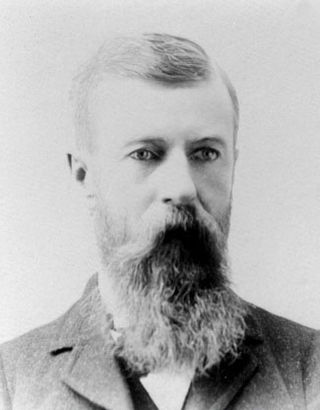
John Cameron[n1] was a merchant and politician in Alberta, Canada and a municipal councillor in Edmonton. He is regarded as one of the city's pioneer citizens.
The Alberta Association of Architects published their Chronicle of Significant Alberta Architecture in February 2003 and August 2005. The project's main goal was to ensure that the public, as well as those with a professional interest in the subject, could easily identify architecturally significant structures developed and still standing in Alberta. The project was undertaken in association with the Government of Alberta.

The Stanley A. Milner Library is the flagship branch of the Edmonton Public Library. It is located on the southern side of Sir Winston Churchill Square in the downtown core of Edmonton, Alberta, Canada. The main library is near walking distance to the City Hall, the Edmonton City Centre mall, the Francis Winspear Centre for Music, and the Citadel Theatre. In January 2017, the library closed its doors for a major renovation, as all but the basic structure was removed to be rebuilt with an architectural design similar to that of the Art Gallery of Alberta located a few blocks away. Its services were relocated to a temporary space on Jasper Avenue in Enterprise Square. The new Stanley A. Milner Library, along with the new Shelley Milner Children's Library opened on September 17, 2020.

The Princess Theatre is a two-screen art-house cinema located at 10337 Whyte Avenue in Edmonton's historic Old Strathcona neighbourhood. The building was designed by prominent Edmonton architects Wilson and Herrald, a firm responsible for the design of many other Edmonton heritage sites. It became Edmonton's oldest surviving theatre after the demolition of the Gem Theatre in 2006. The building currently houses the main 400-seat theatre as well as the 100-seat Princess II, located in the basement.
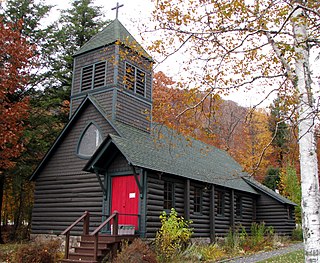
Manly N. Cutter was an architect and interior designer associated with work in New Jersey, Boston, New York City, the state of New York, and Alberta, Canada. He is credited with the design of the National Register of Historic Places listed Saint John's Episcopal Church and Church of the Transfiguration. He also designed the picturesque Gothic architecture St. Patrick's Roman Catholic Church on Broadway in New York City and a church in Medicine Hat (1913–14) in Alberta, Canada.

McKay Avenue School is a former school and historic site in Edmonton, Alberta, Canada. The site is a Provincial and Municipal Historic Resource, and home to the Edmonton Public School Board's archives and museum.
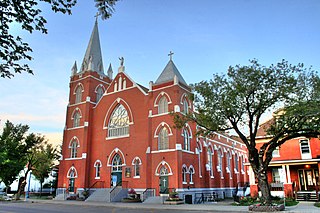
The Sacred Heart Church of the First Peoples is a Roman Catholic church in Edmonton, Alberta. Opened as the Sacred Heart Church in 1913 to serve the city's rapidly growing population, Sacred Heart has been a historic "nursery" for many of Edmonton's immigrant Catholic parishes. In 1991, facing an aging congregation and declining weekly attendance, the parish's inner-city location was seen as an opportunity to serve Edmonton's growing urban Indigenous population. On October 27 of that year, the Archdiocese of Edmonton's Native Pastoral Centre was moved into Sacred Heart as Archbishop Joseph MacNeil declared the church to be a First Nations, Métis, and Inuit national parish, the first of its kind in Canada.
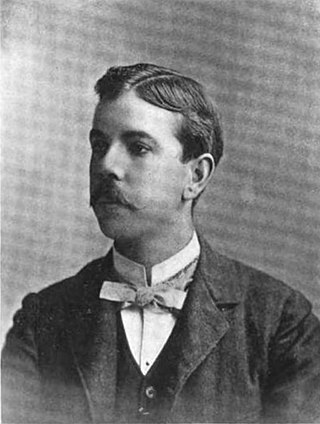
Allan Merrick Jeffers (1875–1926) was an American architect who practiced largely in Alberta, Canada.

Huff Bremner Estate is a neighborhood in northwest Edmonton, Alberta, Canada. Throughout the early twentieth century, Huff Bremner was advertised as a desirable residential neighborhood and it was home to a number of Edmonton families. Beginning in 1952, however, Huff Bremner began to be rezoned as an industrial district. The neighborhood is now sometimes referred to as Huff Bremner Estate Industrial. As of 2022, Huff Bremner contains one municipally-designated heritage building, as well as several restaurants, office buildings, and industrial warehouses.

The Ford Parts and Accessories Depot of Edmonton, Alberta, Canada is a historic building in the neighborhood of Huff Bremner Estate. In 2006, the building was added to the Edmonton Inventory of Historic Sites on the basis of its "Early Modern architecture in the International Style".
Kelvin Crawford Stanley was a Canadian architect based in Edmonton, Alberta from 1946 until 1964. He subsequently worked in Montreal and Ottawa in the late 1960s.

The Paramount Theatre is a historic movie theatre in Edmonton, Alberta, Canada.
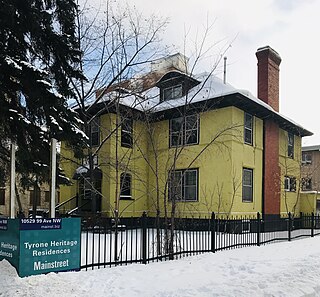
Tyrone Heritage Residences is a heritage building in Edmonton, Canada, best known as the former home of Alberta's third Premier, Charles Stewart.















